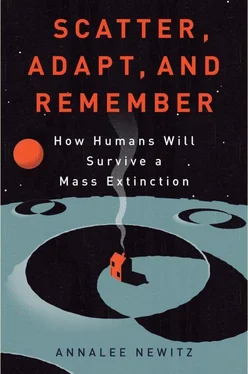“I think we’re on a leading edge,” Barnosky told me. “My take on it is that we’re actually not far into it. A true mass extinction is losing seventy-five percent of species that are recorded. We’ve lost maybe one or two percent of those we can count. So everything we want to save is still out there.” Still, he cautioned, the big problem is not our world right now but the world we’re heading toward over the next century. Looking at the data, he and his colleagues believe that extinction rates for mammals are far above the typical extinction numbers we’d expect for a background rate. “It’s happening too fast,” he sighed. “We’re somewhere between three and twelve times too high.” Given that humans are only likely to expand our territories further into those of endangered animals, he expects these numbers to grow. And when you add in all the carbon we’re pumping into the atmosphere, it’s possible that we’re re-creating the conditions that led to previous mass extinctions.
Peter Ward, a geologist at the University of Washington, who has written about mass extinctions in several books, including his influential work The Medea Hypothesis, believes carbon emissions mean that environmental change is almost inevitable. “We’re going back to the Miocene,” he said, then laughed darkly. The Miocene, a geological age that ended roughly 5.3 million years ago, was the last time that the planet had no Arctic ice cap. It was a period of intense heat when greenhouse conditions reigned and our hominid ancestors had not yet evolved. Though many animals might thrive in the Miocene climate, humans wouldn’t. We are the products of a cold Earth, just like many of our mammal brethren. “We need to keep those ice caps,” Ward said.
The question for scientists like Barnosky and Ward is whether somebody living millions of years from now could look back on our own geological period, the Quaternary, and say that it ended with the sixth mass extinction event on our planet. If so, that would put humans in a class with cyanobacteria as the only life-forms that ever single-handedly brought on an environment-changing event with widespread deadly effects. However, as we’ve seen from looking at previous mass extinctions, it’s impossible to pin the blame for such an enormous event on just a single catastrophe—or a single species’ meddling.
If we are in the early days of a mass extinction, the main thing that sets it apart from the five previous ones is the presence of a species that has the ability to stop it. We are tenacious survivors, incredible inventors, and we’ve demonstrated an ability to plan for the future collectively—even, sometimes, for the good of all rather than the good of the few. One of our most powerful skills in making those plans is our knowledge of history. Not only have we kept records of human history for thousands of years, but we’ve also developed scientific methods of discovering what happened to the planet before we evolved. The geological history we’ve just shot through at top speed is full of information about the kinds of life-eradicating dangers that Earth has confronted over and over. By remembering this history, we can make informed decisions about what to do next in order to ensure our survival as a species.
In the next section of the book, we’ll explore how humans have already made it through tens of thousands of years of environmental catastrophe, disease, and famine. With each blow to our species, we’ve crafted better and better methods of surviving.
PART II
WE ALMOST DIDN’T MAKE IT
6. THE AFRICAN BOTTLENECK
MOST OF US are familiar with the basic outlines of the human evolutionary story. Our distant ancestors were a group of apelike creatures who started walking upright millions of years ago in Africa, eventually developing bigger brains and scattering throughout the world to become the humans of today. But there’s another story that has received less attention. Advances in genetics have given us a sharper understanding of what happened between the “walking upright” and the “buying the latest tablet computer” chapters of the tale.
Written into our genomes is the signature left behind by an event when the early human population dwindled to such a small size that our ancient ancestors living in Africa may have come close to extinction. Population geneticists call events like these bottlenecks. They’re periods when the diversity of a species becomes so constrained that evidence of genetic culling is obvious even thousands of generations later. Sometimes the shrinking of a population is the result of mass deaths, and indeed, there is evidence that humans may have been fleeing a natural disaster when we walked out of Africa roughly 70 thousand years ago. But our species probably experienced multiple genetic bottlenecks beginning as far back as 2 million years. And those earlier bottlenecks were caused by a force far more powerful than mass death: the process of evolution itself.
In fact, the African bottlenecks are an example of the paradoxical nature of human survival. They provide evidence that humans nearly died out many times, but also tell a story about how we evolved to survive in places very far away from our evolutionary home in Africa.
The Fundamental Mystery of Human Evolution
Given our enormous, globe-spanning population size, humans have remarkably low genetic diversity—much lower than other mammal species. All 6 billion of us are descended from a group of people who numbered in the mere tens of thousands. When population geneticists describe this peculiar situation, they talk about the difference between humanity’s actual population size and our “effective population size.” An effective population size is a subgroup of the actual population that reasonably represents the genetic diversity of the whole. Put another way, humanity is like a giant dance party full of billions of diverse people. But population geneticists, elite party animals that they are, have managed to find the one ideal VIP area that contains a small group of people who very roughly capture the diversity of the party as a whole. In theory, that room contains the party’s effective population size. If they all started randomly having sex with each other, their children might loosely reproduce the diversity and genetic drift of our actual, billions-strong population.
The weird part is that compared with our actual population size, the human effective population in that VIP area is very low. In fact, today’s human effective population size is estimated at about 10,000 people. As a point of comparison, the common house mouse is estimated to have an effective population size of 160,000. How could there be so many of us, and so little genetic diversity?
This is one of the fundamental mysteries of human evolution, and is the subject of great debate among scientists. There are a few compelling theories, which we’ll discuss shortly, but there is one point that nearly all evolutionary biologists will agree on. We are descended from a group of proto-humans who were fairly diverse 2 million years ago, but whose diversity crashed and passed through a bottleneck while Homo sapiens evolved. That crash limited our gene pool, creating the small effective population size we have today. Does some kind of terrible disaster lurk in the human past? An event that could have winnowed our population down to a small group of survivors, who became our ancestors? That’s definitely one possibility. Evolutionary biologist Richard Dawkins has popularized the idea that the population crash came in the wake of the Toba catastrophe, a supervolcano that rocked Indonesia 80,000 years ago. It’s possible this enormous blast cooled the African climate for many years, destroying local food sources and starving everybody to death before sending fearful bands of Homo sapiens running out of Africa.
Читать дальше






![Аннали Ньюиц - Автономность [litres]](/books/424681/annali-nyuic-avtonomnost-litres-thumb.webp)





